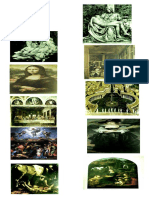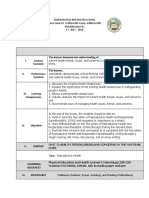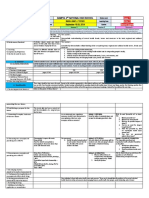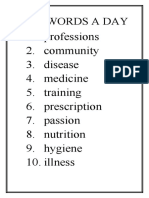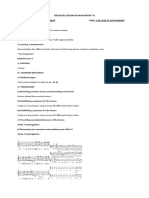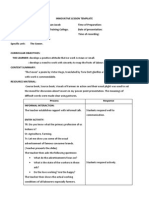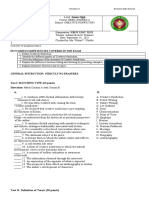0 ratings0% found this document useful (0 votes)
159 viewsDampol 2 National High School: Grade 10 Sara Jane J. Tayao Arts 10 February 3 - 7, 2019/11:30 To 5:30 Fourth Quarter
The document outlines the objectives, standards, resources and procedures for a week-long arts lesson on creating an original theatrical performance inspired by Philippine stories. The objectives include defining the uniqueness of original performances and choreographing movements. Students will watch performances, design costumes and props, assume roles as actors or staff, and analyze what makes performances stand out. Across the week students will work in pre-production, production and technical rehearsal stages to stage their own performance applying theatrical elements and showcasing a local story.
Uploaded by
Sara Jane C. Jose-TayaoCopyright
© © All Rights Reserved
Available Formats
Download as DOCX, PDF, TXT or read online on Scribd
0 ratings0% found this document useful (0 votes)
159 viewsDampol 2 National High School: Grade 10 Sara Jane J. Tayao Arts 10 February 3 - 7, 2019/11:30 To 5:30 Fourth Quarter
The document outlines the objectives, standards, resources and procedures for a week-long arts lesson on creating an original theatrical performance inspired by Philippine stories. The objectives include defining the uniqueness of original performances and choreographing movements. Students will watch performances, design costumes and props, assume roles as actors or staff, and analyze what makes performances stand out. Across the week students will work in pre-production, production and technical rehearsal stages to stage their own performance applying theatrical elements and showcasing a local story.
Uploaded by
Sara Jane C. Jose-TayaoCopyright
© © All Rights Reserved
Available Formats
Download as DOCX, PDF, TXT or read online on Scribd
You are on page 1/ 3
Grades 1 to 12 Daily School DAMPOL 2ND NATIONAL HIGH SCHOOL Grade Level Grade 10
Lesson Log Teacher SARA JANE J. TAYAO Learning Area ARTS 10
Teaching Dates and Time February 3 – 7, 2019/11:30 to 5:30 Quarter Fourth Quarter
Session 5 Session 6 Session 7 Session 8
Objectives must be met over the week and connected to the curriculum standards. To meet the objectives, necessary procedures must be followed and if needed, additional lessons,
I. OBJECTIVES exercises and remedial activities may be done for developing content knowledge and competencies. These are assessed using Formative Assessment strategies. Valuing objectives
support the learning of content and competencies and enable children to find significance and joy in learning the lessons. Weekly objectives shall be derived from the curriculum guides.
A. Content Standard The Learner…
1. How theatrical elements (sound, music, gesture, movement and costume) affect the creation and communication of meaning in a theater play/performance
incorporated with media.
2. Theater and performer as a synthesis of arts
B. Performance Standard The Learner...
1. Create appropriate costumes, props, set accessories, costumes improvised lighting and other décor for Philippine plays
2. Create/improvise sound, music, gesture, and movements for a theatrical composition
3. Participate in an original performance inspired by local Philippine stories, myths, and events relevant to current issues
C. Learning 1. Define the uniqueness of each original performance. 5. Contribute to the conceptualization of an original performance
Competencies/Objectives A10PL-IVh-1 A10PR-IVd-4
Write the LC code for each. 2. Design with a group the visual components of a school play (stage 6. Choreograph the movements and gestures needed in the effective
design, costume, props, etc.) delivery of an original performance with the use of media.
A10PR-IVe-1 7. AP10PR-IV-r-g-5
3. Assume the role of a character as an actor/performance, or 8. Improvise accompanying sound and rhythm needed in the
production staff (director, choreography, light designer, stage effective delivery of an original performance with the use of
manager) different media. AP10PR-IV-r-g-6
A10PR-IVh-2
4. Analyze the uniqueness of the group that was given recognition
for its performance and explain what component contributed to
its selection
A10PR-IVh-3
II. CONTENT Content is what the lesson is all about. It pertains to the subject matter that the teacher aims to teach. In the CG, the content can be tackled in a week or two.
III. LEARNING RESOURCES List the materials to be used in different days. Varied sources of materials sustain children’s interest in the lesson and in learning. Ensure that there is a
mix of concrete and manipulative materials as well as paper-based materials. Hands-on learning promotes concept development.
A. References
1. Teacher’s Guide pages Pages 175 - 177
2. Learner’s Material pages Pages 304 -317
3. Textbook pages
4. Additional Material from
Learning Resource (LR) Portal
B. Other Learning Resources
These steps should be done across the week. Spread out the activities appropriately so that students will learn well. Always be guided by demonstration of learning by
the students which you can infer from formative assessment activities. Sustain learning systematically by providing students with multiple ways to learn new things,
IV. PROCEDURES
practice their learning, question their learning processes, and draw conclusions about what they learned in relation to their life experiences and previous knowledge.
Indicate the time allotment for each step.
A. Reviewing previous lesson or Recall concepts from the past lesson.
presenting the new lesson.
B. Establishing a purpose for the Orient the class on this culminating activity of staging an original theater performance. Every class member would already have been assigned his or
lesson her specific role in the production process, which each one shall then carry out in the course.
As the class watches the performances of Philippine Ballet display on the board pictures of each of the ballet performances both Philippine and Western ballet
pictures of ballerinas.
C. Presenting Examples/ instances 1. Let the students watch and listen to presentations or performances of a To appreciate roles of a production of the t Philippine MUSICAL play
of the new lesson musical play. through group activities like singing and acting.
2. After watching and listening to the musical play, let the Let them analyze the elements of arts applied to an original performance.
students express their personal reactions or feelings about 1. Let the students watch performances of Philippine ballet or Western
these works through group discussion. Report the outcome of ballet on a DVD.
2. Group discussion. Have them express their analysis through personal
the group discussion in class.
reactions or feelings about these works. Then, ask them to report the
outcome of the discussion in the class.
D. Discussing new concepts and PRE-PRODUCTION MID-QUARTER: Production of Sets, Costumes, and Props
practicing new skills #1 1. Sourcing/Writing the Script Design of Lighting and Sound, Using Different Media
-A group of class members will be tasked with sourcing an existing script Start of Acting Rehearsals and Blocking
on a Philippine myth, legend, or folk tale, or dealing with a current issue. All class members should maintain a clear intent to apply the following in
2. Casting the Actor
this particular production.
- Based on the script that has been sourced or written, the characters
will be cast from among the class members. Discuss the Elements and Principles of Art as Applied to an Original
3. Forming the production team. Performance.
-The remaining class members will be assigned the following roles that
are typically required for a school or class play.
E. Discussing new concepts and Technical Rehearsal
practicing new skills #2
F. Developing mastery
(Leads to Formative Assessment 3)
G. Finding practical applications of
concepts and skills in daily living
H. Making generalizations and Theater is an art form that brings together an entire range of art forms-along with their corresponding elements and principles.
abstractions about the lesson
I. Evaluating learning Staging of An Original Performance.
J. Additional activities for
application or remediation
V. REMARKS
VI. REFLECTION Reflect on your teaching and assess yourself as a teacher. Think about your students’ progress this week. What works? What else needs to be done to help the
students learn? Identify what help your instructional supervisors can provide for you so when you meet them, you can ask them relevant questions.
A. No. of learners who earned 80% on the
formative assessment
B. No. of learners who require additional
activities for remediation.
C. Did the remedial lessons work? No. of
learners who have caught up with the
lesson.
D. No. of learners who continue to require
remediation
E. Which of my teaching strategies worked Group Activity.
well? Why did these work?
F. What difficulties did I encounter which
my principal or supervisor can help me
solve?
G. What innovation or localized materials
did I use/discover which I wish to share
with other teachers?
Prepared by: Checked by:
SARA JANE J. TAYAO
Teacher I MA. LEAH F. DALANGIN
Head Teacher I
MARIA LOURDES L. RAMOS
Principal III
You might also like
- Hourglass Workout Program by Luisagiuliet 276% (21)Hourglass Workout Program by Luisagiuliet 251 pages
- Read People Like A Book by Patrick King-Edited57% (82)Read People Like A Book by Patrick King-Edited12 pages
- Livingood, Blake - Livingood Daily Your 21-Day Guide To Experience Real Health77% (13)Livingood, Blake - Livingood Daily Your 21-Day Guide To Experience Real Health260 pages
- Donald Trump & Jeffrey Epstein Rape Lawsuit and Affidavits83% (1016)Donald Trump & Jeffrey Epstein Rape Lawsuit and Affidavits13 pages
- The 36 Questions That Lead To Love - The New York Times94% (34)The 36 Questions That Lead To Love - The New York Times3 pages
- The 36 Questions That Lead To Love - The New York Times95% (21)The 36 Questions That Lead To Love - The New York Times3 pages
- Jeffrey Epstein39s Little Black Book Unredacted PDF75% (12)Jeffrey Epstein39s Little Black Book Unredacted PDF95 pages
- 14 Easiest & Hardest Muscles To Build (Ranked With Solutions)100% (8)14 Easiest & Hardest Muscles To Build (Ranked With Solutions)27 pages
- The 4 Hour Workweek, Expanded and Updated by Timothy Ferriss - Excerpt23% (954)The 4 Hour Workweek, Expanded and Updated by Timothy Ferriss - Excerpt38 pages
- Teacher Learning Area Teaching Dates Quarter Teaching Time Section100% (1)Teacher Learning Area Teaching Dates Quarter Teaching Time Section6 pages
- Music: Quarter 2 - Module 7: Instrumental Music of PalawanNo ratings yetMusic: Quarter 2 - Module 7: Instrumental Music of Palawan22 pages
- Date: Subject: Music SECTION: 8A, 8B, 8C, 8G, 8J MUSIC Grade 8 (Unit IV: Musical Theatre and Festivals of Asia) Content Standard100% (1)Date: Subject: Music SECTION: 8A, 8B, 8C, 8G, 8J MUSIC Grade 8 (Unit IV: Musical Theatre and Festivals of Asia) Content Standard3 pages
- Learning Activity Sheet (LAS) Music 7 - 1 Quarter Week 2No ratings yetLearning Activity Sheet (LAS) Music 7 - 1 Quarter Week 23 pages
- Davao City National High School F, Torres St. Davao City A.Y. 2016-2017 4 A's Lesson Plan in MAPEH - 7 December 13, 2016 MusicNo ratings yetDavao City National High School F, Torres St. Davao City A.Y. 2016-2017 4 A's Lesson Plan in MAPEH - 7 December 13, 2016 Music3 pages
- Third Quarter Mapeh 8: Junior High School Department Labo, Camarines Norte S.Y. 2020-2021100% (1)Third Quarter Mapeh 8: Junior High School Department Labo, Camarines Norte S.Y. 2020-202122 pages
- Quarter 3 Media-Based Arts and Design in The Philippines LAS 5: Photo-ArtgraphyNo ratings yetQuarter 3 Media-Based Arts and Design in The Philippines LAS 5: Photo-Artgraphy7 pages
- MP Health 7 Q1 W7 Growing Holistically Healthy - LAS 1100% (1)MP Health 7 Q1 W7 Growing Holistically Healthy - LAS 16 pages
- Mapeh 7: Music - Arts Physical Education - Health100% (1)Mapeh 7: Music - Arts Physical Education - Health20 pages
- Daily Lesson LOG: School Grade Level Teacher Learning Area Teaching Dates and Time QuarterNo ratings yetDaily Lesson LOG: School Grade Level Teacher Learning Area Teaching Dates and Time Quarter18 pages
- Music: Quarter 1 - Module 5: Secular Music Passion For Harana and BalitawNo ratings yetMusic: Quarter 1 - Module 5: Secular Music Passion For Harana and Balitaw27 pages
- Vdocuments - MX Mapeh 8 Music 4th Quarter Chinese TheaterNo ratings yetVdocuments - MX Mapeh 8 Music 4th Quarter Chinese Theater35 pages
- Write Your Answer in Each Activity in Your MAPEH NotebookNo ratings yetWrite Your Answer in Each Activity in Your MAPEH Notebook6 pages
- Weekly Learning Plan: Department of EducationNo ratings yetWeekly Learning Plan: Department of Education3 pages
- Subject: Music Grade Level: 7 Quarter: Fourth QuarterNo ratings yetSubject: Music Grade Level: 7 Quarter: Fourth Quarter2 pages
- Fourth Periodic Test: Table of SpecificationsNo ratings yetFourth Periodic Test: Table of Specifications2 pages
- Title of Artwork: Name of Artist: Era: DescriptionNo ratings yetTitle of Artwork: Name of Artist: Era: Description1 page
- RAGTIME - Is An American Popular Musical Style: Jazz MusicNo ratings yetRAGTIME - Is An American Popular Musical Style: Jazz Music9 pages
- Better Is A Poor Person Who Walks in His Integrity Than One Who Is Crooked in Speech and Is A Fool. - Proverbs 19:1No ratings yetBetter Is A Poor Person Who Walks in His Integrity Than One Who Is Crooked in Speech and Is A Fool. - Proverbs 19:14 pages
- Dampol 2 National High School Dampol 2 A Pulilan, Bulacan Third Quarterly Test in M.A.P.E.H. - 9 Music - 9No ratings yetDampol 2 National High School Dampol 2 A Pulilan, Bulacan Third Quarterly Test in M.A.P.E.H. - 9 Music - 94 pages
- Daily Lesson Plan: Understands The Concepts and Principles of Selecting and Using Consumer Health Products100% (2)Daily Lesson Plan: Understands The Concepts and Principles of Selecting and Using Consumer Health Products2 pages
- Constructing A Replacement For The Soul - BourbonNo ratings yetConstructing A Replacement For The Soul - Bourbon258 pages
- Overseas Employment Corporation: Career Opportunities in Oec On ContractNo ratings yetOverseas Employment Corporation: Career Opportunities in Oec On Contract2 pages
- African National Congress: Department of Information and Publicity100% (2)African National Congress: Department of Information and Publicity9 pages
- CEFR in Malaysia: Current Issues and Challenges in The Implementation of The FrameworkNo ratings yetCEFR in Malaysia: Current Issues and Challenges in The Implementation of The Framework12 pages
- Innovative Lesson Template - Selin - The SowerNo ratings yetInnovative Lesson Template - Selin - The Sower2 pages
- BDelosAngelesIII - CLASSIFICATIONS OF RESEARCH PDFNo ratings yetBDelosAngelesIII - CLASSIFICATIONS OF RESEARCH PDF12 pages
- Akhil Maurya: An Enthusiastic & Energy-Driven Professional Pursuing Entry-Level Assignment As ProductionNo ratings yetAkhil Maurya: An Enthusiastic & Energy-Driven Professional Pursuing Entry-Level Assignment As Production2 pages





























































































